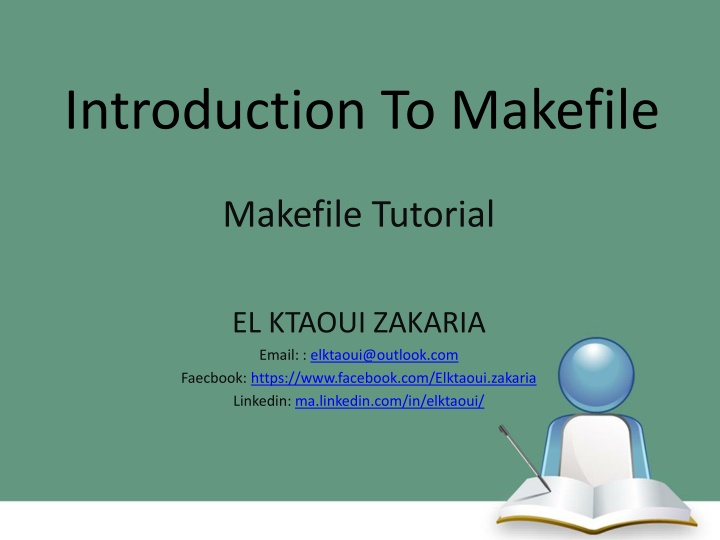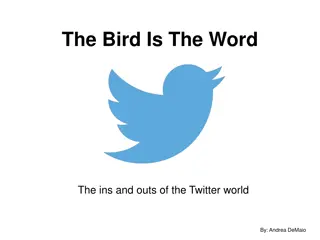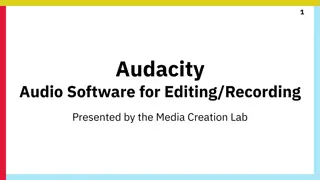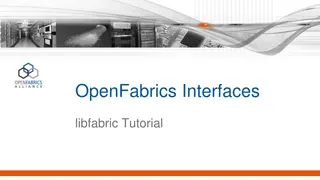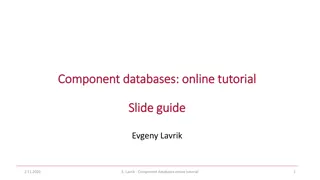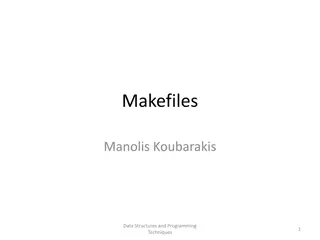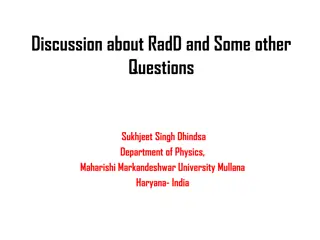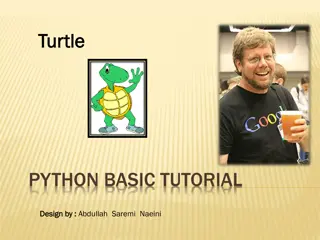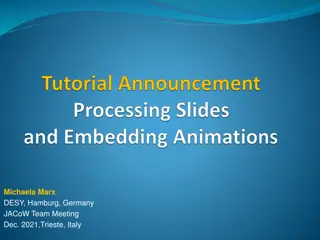Introduction to Makefile: A Comprehensive Tutorial
Makefile, an enduring utility in Unix and other operating systems, automates determining the recompilation of program components. This tutorial explores the significance, functionality, and usage of Makefile, making it an essential tool for efficient project builds.
Download Presentation

Please find below an Image/Link to download the presentation.
The content on the website is provided AS IS for your information and personal use only. It may not be sold, licensed, or shared on other websites without obtaining consent from the author.If you encounter any issues during the download, it is possible that the publisher has removed the file from their server.
You are allowed to download the files provided on this website for personal or commercial use, subject to the condition that they are used lawfully. All files are the property of their respective owners.
The content on the website is provided AS IS for your information and personal use only. It may not be sold, licensed, or shared on other websites without obtaining consent from the author.
E N D
Presentation Transcript
Introduction To Makefile Makefile Tutorial EL KTAOUI ZAKARIA Email: : elktaoui@outlook.com Faecbook: https://www.facebook.com/Elktaoui.zakaria Linkedin: ma.linkedin.com/in/elktaoui/
Table of Content Introduction Why Makefile ? How does it work ? How to Make a simple Makefile ? Makefile Rules
Introduction The utility simply known as make is one of the most enduring features of both Unix and other operating systems. First invented in the 1970s, make still turns up this day as the most programming projects; it even builds the Linux kernel. to central engine in
Automatically determines which pieces of a large program need to be recompiled and issues the command to recompile them First implemented by Richard Stallman and Ronald McGrath. Development since version 3.76 is handled by Paul D. Smith
In this presentation you will learn why this utility continues to hold its top position in project build software, despite many younger competitors.
Makefile Why ? Make checks timestamps to see what has changed and rebuilds just what you need, without wasting time rebuilding other files. Manage Several source files and compile them quickly with a single Command Line. Make layers a rich collection of options that lets you manipulate multiple directories, build different versions of programs for different platforms, and customize your builds in other ways.
Make Utility If you run make This will cause the make program to read the makefile and build the first target it finds there. If you have several makefiles, then you can execute them with the command: make -f mymakefile For more options use : $ man make
How does it work ? Typically the default goal in most makefiles is to build a program. This usually involves many steps: 1. Generate the source code using some utilities like Flex & Bison. 2. Compile the source code into binary file (.o files c/c++/java etc .. 3. bound the Object files together using a linker( gcc/g++) to form an executable program(.exe)
How does it work ? Makefile contains a set of rules used to build an application. The first rule (default rule) seen by make consists of three parts: The Target. The Dependencies. The Command to be performed.
Target and Dependencies Now let s see the Make Process : Make is asked to evaluate a rule, it begins by finding the files indicated by the dependencies and target. If any of the dependencies has an associated rule, make attempts to update those first. Next, the target file is considered. If any dependency is newer than the target, the target is remade by executing the commands. If any dependency is newer than the target, the target is remade by executing the commands.
How to Make a Simple Makefile Exec: projet.o test.o g++ o exec projet.o test.o projet.o: projet.c gcc o projet.o c projet.c Wall Test.o: test.c gcc o test.o c test.c -Wall
How to Make a Simple Makefile The target file Exec appears before the colon. The dependencies project.c and test.o appear after the colon. The command Line usually appears on the following lines and is preceded by a tab character.
How to Make a Simple Makefile When this makefile is executed for the first time, we see: $ make gcc o projet.o c projet.c Wall gcc o test.o c test.c-Wall gcc o exec projet.o test.o As you look at the makefile and sample execution, you may notice the order in which commands are executed by make are nearly the opposite to the order they occur in the Makefile.. Now we have an executable program
How to Make a Simple Makefile But How He did that : 1. First make notices that the command line contains no targets so it decides to make the default goal, Exec(Our Executable) . 2. It checks for dependencies and sees three: project.o main.o now considers how to build projetc.o and main.o and sees a rule for it 3. Again, it checks the dependencies, notices that project.c has no rule but (that file exists), so make executes the commands to transform project.c into project.o by executing the command ! gcc o projet.o c projet.c Wall
Makefile Rules In the last section, we wrote some rules to compile and link our program. Each of those rules defines a target, that is, a file to be updated. Each target file depends on a set of dependencies, which are also files. Since rules are so important in make, there are a number of different kinds of rules. Explicit rules (This is the most common type of rule you will be writing), and Implicit rules.
Makefile Rules A makefile often contains long lists of files. To simplify this process make supports wildcards (also known as globbing). Wildcards can be very useful for creating more adaptable makefiles. For instance, instead of listing all the files in a program explicitly, you can use wildcards define a rule that applies to all files ending in the %.o and %.c suffix. Automatic variables are set by make after a rule is matched. They provide access to elements from the target and dependency (so you don t have to explicitly specify any filenames) Variables (Constants) : some can be set by the user to control make s behavior while others are set by make to communicate with the user s makefile.
Makefile Rules Use WildCard: %.o: %.c gcc o $@ c $< Wall Explanation : The .o files depends on the .c files. To generate the .o file, we needs to compile the .c file. $@ define the filename of the target. $< define the filename of the first dependency. 1. 2. 3. 4.
Makefile Rules Define Variables : CC=gcc WFLAGS=-Wall OBJ=projet.o test.o Exec: $(OBJ) $(CC) o $@ $^ $(WFLAGS) %.o: %.c $(CC) o $@ c $< $(WFLAGS) Explanation : In this exemple we defined some variables CC,WFLAGS,OBJ. Variable name must be surrounded by $() or ${}. A single character variable name does not require the parentheses.
Makefile Rules Automatic Variables: They provide access to elements from the target and prerequisite lists so you don t have to explicitly specify any filenames. They are very useful for avoiding code duplication. Exec: $(OBJ) $(CC) o $@ $^ $(WFLAGS) %.o: %.c $(CC) o $@ c $< $(WFLAGS) $@ The filename representing the target. $< The filename of the first dependency. $^ The filenames of all the dependencies.
Conclusion Phony Target : Simple Target to run Command line, Dont create files,most phony targets do not have prerequisites. Standard Phony Target : Make clean Make all Make install .PHONY: clean clean: rm f *.o
Conclusion Remarks: Don t forget about the TAB Before the Command. Read Tutorials and practice with simple Example. Send Message on Social Media feel free to Ask.
Writing a Makefile: Comments `#' in a line of a Makefile starts a comment It and the rest of the line are ignored, except that a trailing backslash not escaped by another backslash will continue the comment across multiple lines Within a define directive, comments are not ignored during the definition of the variable, but rather kept intact in the value of the variable When the variable is expanded they will either be treated as make comments or as command script text, depending on the context in which the variable is evaluated
Running make How to name you Makefile? By default, when make looks for the Makefile, it tries the following names, in the order: (1)GNUmakefile, (2)makefile and (3)Makefile. The name GNUmakefile is not recommended If make finds none of them in current directory it will exit throwing No target to build For non-standard names of Makefile, run make with option file | -f as in: make f my_make
Running make Targets for your Makefile You can specify different targets for your Makefile to run with and produce different result: all, -debug, -clean, -release, -install If no target is mentioned, make will run with the default target mentioned in the Makefile as default: Avoiding recompilation: The touch t option Run make to recompile all the files Make changes in the necessary files and run make t This will mark all the object files as up to date Next time running make will not recompile modified files
Running make Exit status of make: 0 The exit status is zero if make is successful. 2 The exit status is two if make encounters any errors. It will print messages describing the particular errors. 1 The exit status is one if you use the `-q' flag and make determines that some target is not already up to date
convert: cmdline.o convert.o g++ $^ -o $@ G++ cmdline.o convert.o o convert convert.o: convert.cpp convert.h g++ -c $< g++ -c convert.cpp cmdline.o: cmdline.cpp cmdline.h convert.h g++ -c $< g++ -c cmdline.cpp
Reference http://www.gnu.org/software/make/manual/ma ke.html#Running http://www.cs.duke.edu/~ola/courses/programm ing/Makefiles/Makefiles.html http://publib.boulder.ibm.com/infocenter/cchelp /v7r0m0/index.jsp?topic=/com.ibm.rational.clear case.cc_ref.doc/topics/clearmake.options.htm http://ftp.gnu.org/gnu/make/ make repository
